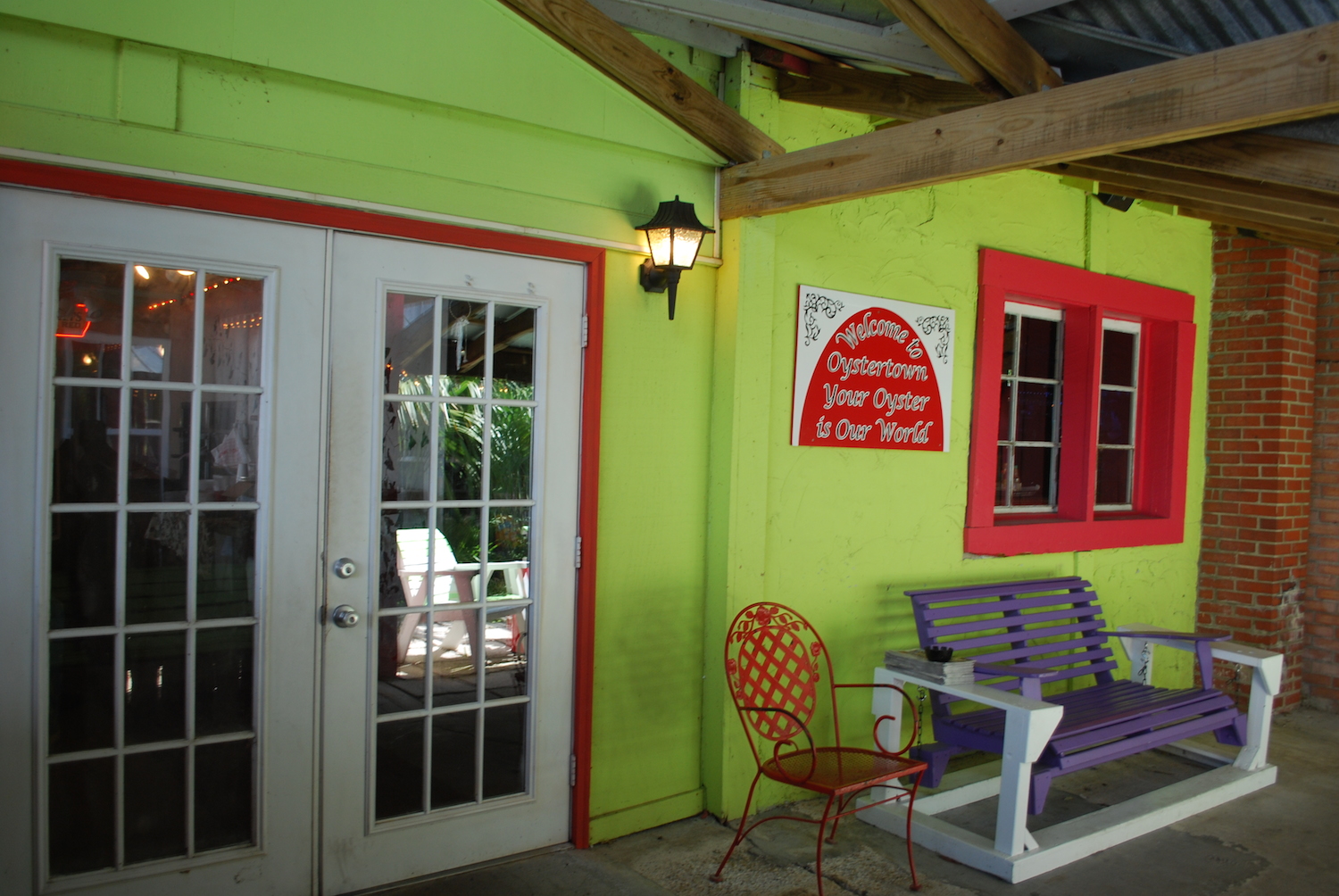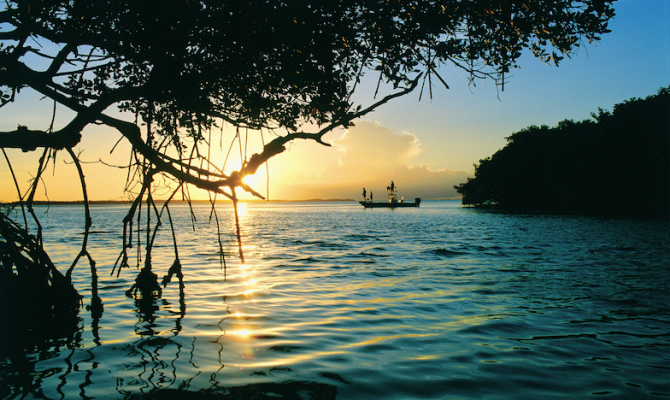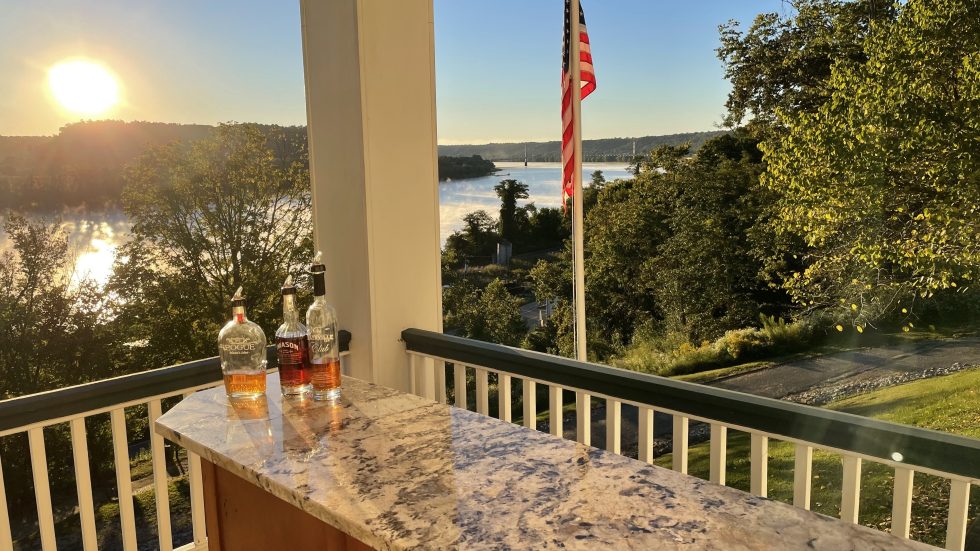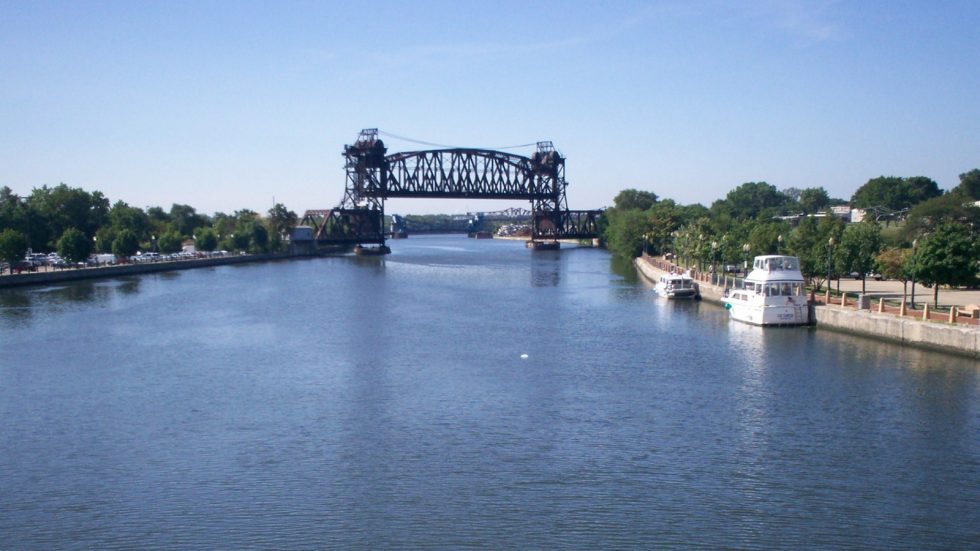On the dock behind the Apalachicola Maritime Museum, which is stuffed with artifacts from the town’s storied past, I board the Starfish Enterprise, the facility’s 40-foot catamaran. The museum offers a variety of eco-tours, including the three-hour one I’m taking today that travels through the Apalachicola River Basin.
Accompanying us is the museum’s founder and local boy-made-good George Floyd, a dedicated environmentalist whose family settled here in the 1840s. After working in the family cannery and building boats with his dad, Floyd moved away, developed a medical records software program, became wealthy and returned to establish a wooden boat-building school to help bring traditional boating crafts and jobs back to Apalachicola.
As Floyd talks, we pass old shrimp trawlers abandoned alongside the edges of the cypress-lined estuary, the nursery grounds for 75 percent of the marine life in the area. We navigate through one of the few remaining swing bridges in the nation and watch happy dolphins crest the surface of the calm waters. Turtles rest on half submerged logs in the calm waters. Countless species of birds flit among the trees. Manatees, who also frequent these waters, unfortunately are not to be seen this day.
A true “old Florida” sort of place, Apalachicola, located east of Panama City on the Gulf of Mexico, has the sort of forgotten-by-time ambience that many of us boaters love so well. Its charming, mid-19th-century downtown and abundance of Queen Anne and Victorian homes are fronted on nearly all sides by water. This includes the 246,000-acre Apalachicola National Estuarine Research Reserve (the second largest in the U.S.), the Apalachicola River, the Gulf Intracoastal Waterway, and the St. George and St. Vincent sounds — prime breeding grounds for oysters.
Indeed, call this Oyster Central, as Apalachicola harvests more than 90 percent of the bivalves sold in Florida and 10 percent of the nationwide supply. The historic downtown has several oyster restaurants, including the waterfront restaurants Boss Oyster and Up the Creek Raw Bar. You can even go with one of the charters from Journeys of St. George Island and try to scoop your own.

Authentic Tastes
Of course, all this water means plenty of fishing. Pompano, mackerel and redfish abound in the bays and flats, while deep-sea fishing might mean snagging grouper, tarpon and snapper. Or you can go even deeper, casting a line for sharks. Boat, kayak and personal watercraft rentals abound, as do marinas and charter fishing excursions.
Indeed, this area is prime for boaters of all ilk—power, sailing and even stand up paddle boarding—with services ranging from private and municipal marinas for any size watercraft. The 30-room Water Street Hotel & Marina has 20 boat slips as well as a pool and is only four blocks from the downtown.
Not big on casting and reeling? Eat what others catch at Tamara’s Café. Chef/owner Danny Itzkovitz prepares dishes such as pecan-encrusted grouper fingers with a creamy jalapeno sauce and shrimp, scallops, grouper, sausage and chicken paella, along with the day’s catch.
Speaking of right off the boat: Itzkovitz shows us a still-flapping red snapper that doesn’t know yet he’s on the dinner menu. Then the chef whisks it away, returning in 20 minutes with the fish now on large platter, grilled and studded with garlic.
After dinner I stroll the downtown, wandering into a place selling sweets. I pick out an assortment of deep, rich chocolates at Apalachicola Chocolate Company and then hand owner George Stritkus my credit card, which he immediately hands back.
“I run my business the way I want, and that means no business cards, no website and no credit cards,” he says proudly. Noting my crestfallen face, he adds, “If you don’t have enough cash, just come back later and pay me.”
Did I hear right? Guess so, as Stritikus pushes the box of chocolates I selected on back towards me. I’m on my way — out of his corner shop with its old-fashioned glass-and-wood display cabinets and on to an ATM. Upon returning, Stritkus smiles sagely as I buy more chocolates and pay cash for both purchases.
“People always come back,” he says. “They like my candy.”
Living History
Stritikus isn’t the only one living life his way. In the short time I’m in Apalach, as the locals call it, I encountered many free spirits dancing to their own piper tunes.
“I had to climb into the dining room window to see what this place looked like,” says Lynn Wilson, the owner of Coombs House Inn, a Grand Victorian built in 1905 that was swept by a kitchen fire in 1911 and then sat vacant and decaying for the next 70 years. “The doors were blocked by debris.”
Determined to own the home despite coming face-to-face with a screech owl in a dark upstairs bathroom, Wilson spent a decade trying to purchase it and another two years fixing it up. Her effort was rewarded; Travel + Leisure named it one of the “30 Outstanding Small Inns in the United States.”
At the time Wilson was crawling through windows, Apalach, having gone through several booms and busts in its almost 200 years, was down on its luck. But Wilson, owner and founder of an international interior design firm, became addicted to restoration and soon redid even more historic properties, including the Cotton Warehouse, now a cultural center, and the Sponge Exchange.
Others, too, saw the ghostly beauty in abandoned and ramshackle buildings, and now 900 homes and buildings, some dating back to the 1830s, are listed as part of the town’s National Historic District.
This taste for whimsy stretches far back in Apalachicola’s past. When Florida State Parks took over the 1839 home of Thomas Orman in 1994, the last of the Orman riches were gone. Gaslights still lit the once glamorous home, and the one elderly remaining Orman lived in the dilapidated back of the house, seceding the front rooms and their high ceilings and marble fireplaces to a horse named Candybar, who grazed on the front lawn during the day and slept in the parlor at night.
The grounds of the restored mansion, now a museum, are dedicated to Dr. Alvin Chapman, the first botanist in the U.S. to study outside the Northeast. Chapman moved to Apalachicola, but his northern sensibilities prevailed, and during the Civil War he assisted escaping Union soldiers. When disapproving Confederate soldiers came looking, Chapman hid in the Episcopalian Church. Built in 1836, it is the sixth oldest church in the state.
Dr. John Gorrie, a friend of Orman and Chapman, invented refrigeration and air conditioning after watching too many of his patients die of tropical diseases in the torrid heat. Though Gorrie’s 1851 invention was a success, the muscular ice industry up north prevented him from getting commercial financing. He died heartbroken and disillusioned. But his ice machine is displayed at the John Gorrie Museum State Park, across the street from the Episcopal Church.
Island Time
Later I travel the causeways and bridges that connect Apalachicola to the 28-mile St. George Island, where I meet friends paddling part of the 1,600-mile Florida Circumnavigational Saltwater Paddling Trail.
The island, a barrier reef surrounded by Apalachicola Bay and the Gulf of Mexico, has handled its growth in a way that is respectful of the environment. Condos and homes tucked away in the sand dunes blend well with the native grasses and trees. Shopping areas eschew garishness and offer wine tastings, gourmet foods and boutique shopping. There’s the newly built (but looks like it’s been there forever) 79-foot-tall St. George Island Lighthouse, and at the far eastern shore is the St. George Island State Par, which like the rest of the island is definitely dog friendly.
My friends’ trip is three days long, but I join them for about three hours. As we kayak close to a shore edged with twisted live oaks draped in gauzy Spanish moss, slash pines that were planted decades ago to replace the trees lost after the area was clear cut and an abundance of small but colorful wildflowers, we look for bald eagles said to nest here but settle for wise-looking pelicans. It’s sweaty work, but there are plenty of sandy beaches from which to cool off.
But though the water is refreshing, as I head back to the Coombs Inn in my rented car, I thank Dr. Gorrie for his invention.
Author: Jane Ammeson is a contributor to HeartLand Boating
Tourism
Apalachicola Bay Tourism, (850) 653-9419, apalachicolabay.org
Marinas
Apalachicola Marina, (850) 653-9521
Apalachicola Municipal Marina, (850) 653-9319
Apalachicola River Inn, (850) 653-8139, apalachicolariverinn.com
Scipio Creek Marina, (850) 653-8030, scipiocreekmarina.com
Water Street Hotel & Marina, (850) 653-3700, waterstreethotel.com
Food & Drink
Apalachicola Chocolate Company, (850) 370-6937
Boss Oyster, (850) 653-9364, bossoyster.com
Up the Creek Raw Bar, (850) 653-2525, thekerib.wix.com/up-the-creek
Tamara’s Café, (850) 653-4111, tamarascafe.com
Lodging
Coombs House Inn, (888) 244-8320, coombshouseinn.com
Attractions
Apalachicola Maritime Museum, (850) 653-2500, ammfl.org
Apalachicola National Estuarine Research Reserve, (850) 670-7700, apalachicolareserve.com
Florida Circumnavigational Saltwater Paddling Trail, dep.state.fl.us/gwt/paddling/saltwater.htm
Historic Trinity Episcopal Church, (850) 653-9550, mytrinitychurch.org
John Gorrie Museum State Park, Orman House Historic State Park and John Chapman Gardens, 850-245-2157, floridastateparks.org
Journeys of St. George Island, (850) 927-3259, sgislandjourneys.com




